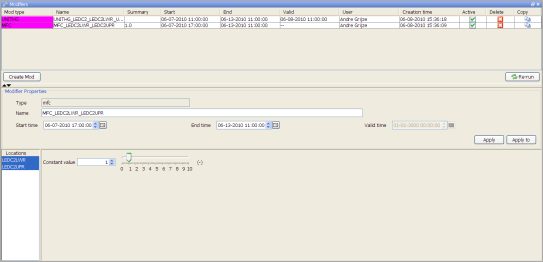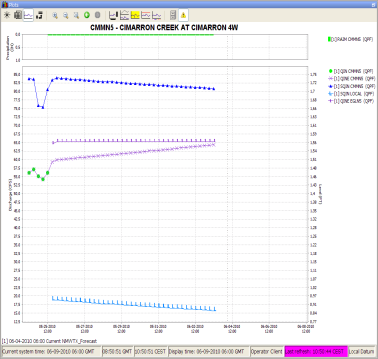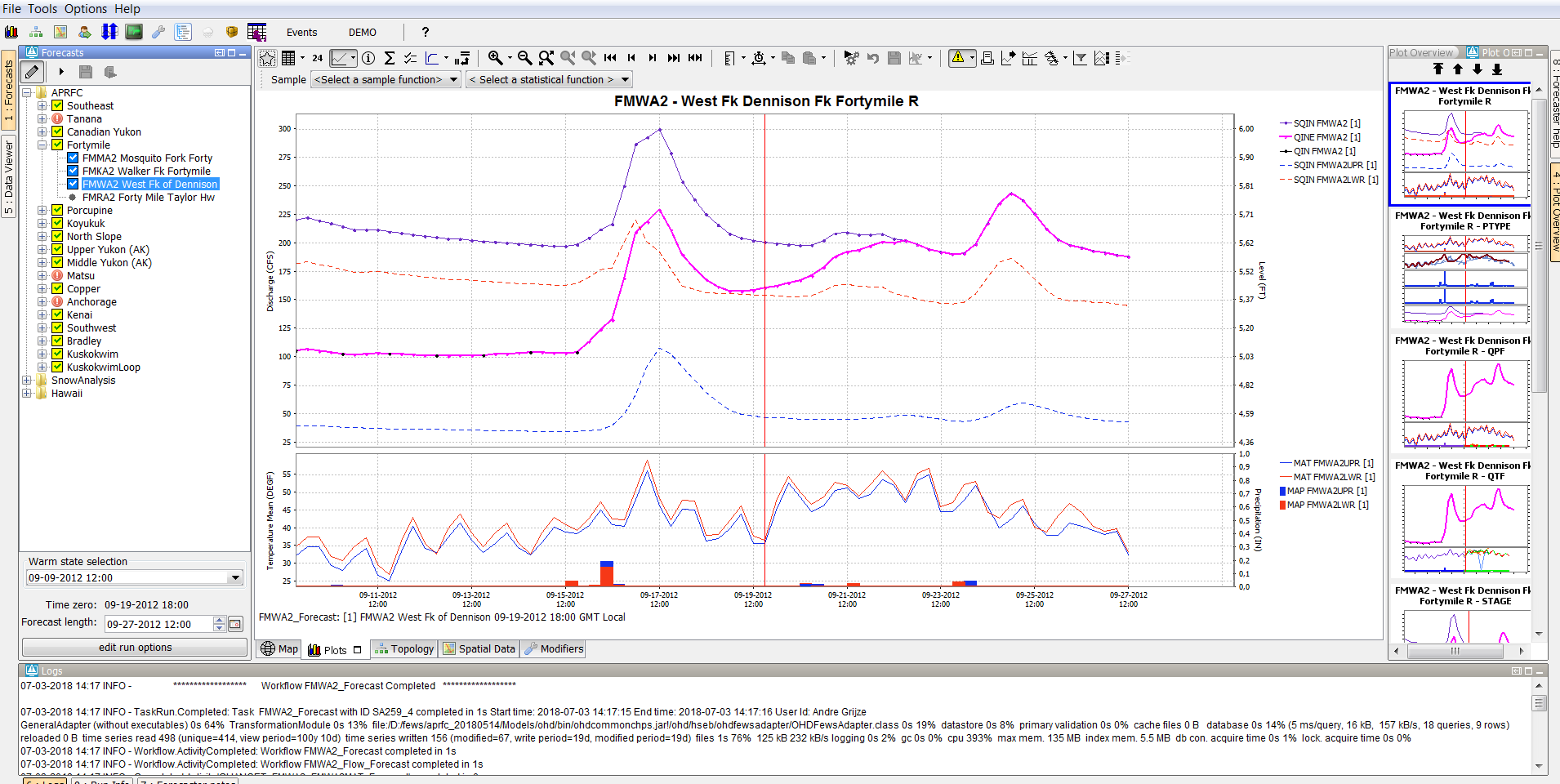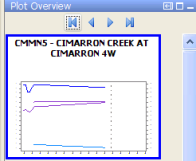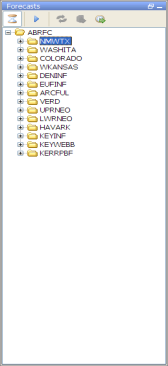...
The first IFD FEWS systems had a button bar which looked like thiswith a lot more buttons (shown below). This original bar can be activated by using the topology.xml.
...
The pencil button can be used to switch between edit-mode and readonlyread only-mode. The second arrow button is used to step to the next leaf node in the topology tree.
The third button is used to start a workflow in IFD mode.This button is only activated when a local run node (usually a leaf node) is selected.
The fourth button is only activated when a group node is selected. It can be used to start all the workflows of the group node in IFD-mode.
...
- workflow nodes: nodes which can be used to start forecasts and view the results of their forecasts,
- view nodes: nodes without a forecastworkflow, these nodes are used for viewing purposes.
...
- Running,
- Pending,
- Failed,
- SuccesfullSuccesfull but a previous node has an invalid status,
- Succesfull but the time zero of the run is different then the time zero of the IFD,
- Succesfull but the workflow needs to be rerun because the state selection was changed, a modifier was created after the run or the forecast length is changed,
- A combination of the 2 statuses above.
Below an overview of all the combinations which are available for a succesfull run (local or server).
...
When a modifier is made at a node with a local succesful successfull run then the icon will change to a yellow icon to indicate that the workflow of that node needs to rerun.
...
The results of a node can only be valid if all the previous nodes have run succesfully successfully prior to the run of a node and when all the previous nodes have valid status.
...
It shows the modifiers which are created for a certain nodethe selected node in the forecast panel. Modifiers can be created, modified or deleted in this panel.
The upper part of the display gives an overview of the modifiers created for the currently selected node in the forecaster panel. When a modifier is selected in this panel, the details will be shown in
the lower part of the panel
It lists the Start Date, the End Date, the Valid Date and the Creation time of the mod.
It also allows the user to make mods active and inactive with the checkbox in the column Active.
A mod can be deleted by pressing the red cross icon and a copy can be made pressing the copy-icon.
With the create mod-button the forecaster can create new modifiers. When the button is pressed a dropdown-list with the available modifier types for the currently selected node is shown.
The modifiers which are shown are depended on the models, transformations and module parameterfiles available in the workflow of the selected node and the plots which are associated with the node.
In the modifierTypes.xml is defined which modifiers are available for the forecaster. The combination of the configuration of the modifierTypes.xml and the workflow and the time series in the plots
When a modifier type is selected, the details of the new modifier is shown is in the lower part of the display. In some cases it is also necessary to specify to which models the modifier should be applied.
For example when the forecaster selects the modifier type MFC and there are two SNOW17-models available in the segment, the forecaster should also specify to which models the modifier should be applied.
When the modifier can be applied to more than one model in a basin a 'location'-panel shows up at the left part of the details display. In this panel the forecaster can select to which locations the modifier should be applied.
The Re-run button runs the workflow from the selected node and the workflows from the upstream nodes.
The lower part of the display shows the details of the selected modifier or when the forecaster is creating a new modifier the details of the new modifier.
Topology panel
Topology panel
The topology panel shows the topology of the selected node. When a leaf node is selected the topology of the children of the The topology panel shows the topology of the selected node. When a leaf node is selected the topology of the parent node is shown. When a parent node is selected the topology of its children is shown.
The colors of the boxes in the topology change when a threshold is passed. The color of the box and the thresholds which are monitored can be configuredare configurable in the threshold module of FEWS.
Plot display
The plot display is used to show scalar time series. Each node has its own set of predefined displays configured. When a node is selected the plots display automatically updates the plots which are already displayed to show data for the new node. The first plot configured for the selected node is automatically shown in this display.
topology node is connected to a display group. After selecting a topology node the first plot of that display group will be shown automatically. If there is already a node selected then FEWS will first to to find a plot with the same location and parameter as currently displayed if that is not possible then the first plot will be displayed.
When the IFD is started, there is always at least one plot display available. This plot is called the primary plot display. The primary plot doesn't have lock icon at the left of the toolbar. When a new plot display is started this plot will have a lock icon at the left on the toolbar. When a new plot displayed is started, by default the plot will be locked.
When a plot is locked, the display is locked to that set of time series. When the forecaster moves from basin to basinselects another node, the plot will continue to display the original timeseries. The plot is not updated. However, as time series and will change. However when new data is brought in, the plot is updated with new data.
When the toggle-button is switched off (icon changes to unlock) the plot window is updated automatically when a new node is selected.
...
The plot overview is a panel which shows a thumbnail of each plot which is configured for the selected node. This panel gives an overview of the selected node. This overview is enabled by configuring the following task in the explorer tasks; nl.wldelft.fews.gui.plugin.displaythumbnails.ShortcutsThumbnailsDialogthe selected node. This panel gives an overview of the selected node.
When a plot is selected the primary plot is automatically updated, also other plots display which are not locked (see previous chapter) are updated. Primary plot is defined by including the following task in the explorer tasks: nl.wldelft.fews.gui.plugin.timeseries.PlotsTimeSeriesDialog. Is such task is not defined the Plot Overview works only if a time series dialog window is open.
locked (see previous chapter) are updated.
At the top of the panel there are four buttons. The first button selects the first plot, the second button selects the previous plot, the third button selects the next plot and the last button selects the last plot.
Forecaster help
The forecaster help panel shows user provided documentation which is available for a node.
Currently the following formats are supported: textfiles, images and pdf-files.
Users can place documents in a directory within predefined directories.
These directories can be configured in the topology.xml configuration file by adding a forecasterHelperDirectories element that contains a directory element for all directories.
...
The content of the forecast help dialog is depended dependet of which node is selected in the forecaster panel.
When a new node is selected the content of the forecaster help dialog is automatically updated.
...
Below is a list of all possible steps in creating a forecast with the IFD. Please note that not all of the listed steps are obligated. For each step will be explained how this step can be carried out using the IFD in FEWS.
- Start FEWS
- Selecting the forecast panel
- Reviewing the topology
- Review the list of available state date/times
- Adjust state and/or forecast length
- Starting the forecast process and selecting the workflow for which the forecast should be made
- Reviewing workflow status
- Reviewing graphs (graph display listens to segment topology selection)
- Reviewing graphs (graph display is independed independent from segment topology selection)
- Continue with the forecast process downstream
- Ending the forecast process
...
After starting FEWS, the map-display will be displayed in the centre and the Forecast Panel-tab at the left will be selected.
This the default layout. The layout after starting FEWS is however configurable by creating and saving a custom layout by using the option in the File menu at the top left of the display.
First the IFD will try to synchronize the local datastore with the central database.
Until that process is finished it layout by using the option Save layout in the File menu.
It is not possible to create a forecast with the IFDmodifiers in a synchronization client until the local datastore is fully synched with the central data store.
To indicate that the IFD is doing its initial synchronization after startup the forecast-button shows a hour glass icon.
While the Operator Client if synchronizing, it is possible to view scalar and spatial data.
When the initial synchronization is finished . The following message is shown.
the icon will change to a pencil icon to indicate that it is possible to create modifiers.
Selecting the forecast panel
...


